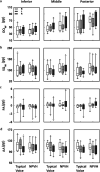Lombard Effect in Individuals With Nonphonotraumatic Vocal Hyperfunction: Impact on Acoustic, Aerodynamic, and Vocal Fold Vibratory Parameters
- PMID: 35930680
- PMCID: PMC9913286
- DOI: 10.1044/2022_JSLHR-21-00508
Lombard Effect in Individuals With Nonphonotraumatic Vocal Hyperfunction: Impact on Acoustic, Aerodynamic, and Vocal Fold Vibratory Parameters
Abstract
Purpose: This exploratory study aims to investigate variations in voice production in the presence of background noise (Lombard effect) in individuals with nonphonotraumatic vocal hyperfunction (NPVH) and individuals with typical voices using acoustic, aerodynamic, and vocal fold vibratory measures of phonatory function.
Method: Nineteen participants with NPVH and 19 participants with typical voices produced simple vocal tasks in three sequential background conditions: baseline (in quiet), Lombard (in noise), and recovery (5 min after removing the noise). The Lombard condition consisted of speech-shaped noise at 80 dB SPL through audiometric headphones. Acoustic measures from a microphone, glottal aerodynamic parameters estimated from the oral airflow measured with a circumferentially vented pneumotachograph mask, and vocal fold vibratory parameters from high-speed videoendoscopy were analyzed.
Results: During the Lombard condition, both groups exhibited a decrease in open quotient and increases in sound pressure level, peak-to-peak glottal airflow, maximum flow declination rate, and subglottal pressure. During the recovery condition, the acoustic and aerodynamic measures of individuals with typical voices returned to those of the baseline condition; however, recovery measures for individuals with NPVH did not return to baseline values.
Conclusions: As expected, individuals with NPVH and participants with typical voices exhibited a Lombard effect in the presence of elevated background noise levels. During the recovery condition, individuals with NPVH did not return to their baseline state, pointing to a persistence of the Lombard effect after noise removal. This behavior could be related to disruptions in laryngeal motor control and may play a role in the etiology of NPVH.
Supplemental material: https://doi.org/10.23641/asha.20415600.
Figures




Similar articles
-
Glottal Aerodynamics Estimated From Neck-Surface Vibration in Women With Phonotraumatic and Nonphonotraumatic Vocal Hyperfunction.J Speech Lang Hear Res. 2020 Sep 15;63(9):2861-2869. doi: 10.1044/2020_JSLHR-20-00189. Epub 2020 Aug 5. J Speech Lang Hear Res. 2020. PMID: 32755502 Free PMC article.
-
Glottal Aerodynamic Measures in Women With Phonotraumatic and Nonphonotraumatic Vocal Hyperfunction.J Speech Lang Hear Res. 2017 Aug 16;60(8):2159-2169. doi: 10.1044/2017_JSLHR-S-16-0337. J Speech Lang Hear Res. 2017. PMID: 28785762 Free PMC article.
-
Simplified Vocal Efficiency Metrics Normalize Following Voice Therapy in Subgroups of Patients With Nonphonotraumatic Vocal Hyperfunction.Am J Speech Lang Pathol. 2025 Aug 13:1-18. doi: 10.1044/2025_AJSLP-25-00040. Online ahead of print. Am J Speech Lang Pathol. 2025. PMID: 40802550
-
Integrative Insights into the Myoelastic-Aerodynamic Theory and Acoustics of Phonation. Scientific Tribute to Donald G. Miller.J Voice. 2023 May;37(3):305-313. doi: 10.1016/j.jvoice.2021.01.023. Epub 2021 Mar 18. J Voice. 2023. PMID: 33744068 Review.
-
Voice therapy for vocal fold paralysis.Otolaryngol Clin North Am. 2004 Feb;37(1):105-19. doi: 10.1016/S0030-6665(03)00163-4. Otolaryngol Clin North Am. 2004. PMID: 15062689 Review.
Cited by
-
Modeling voice production and self-perception in noise: Understanding the Lombard effect in non-phonotraumatic vocal hyperfunctiona).J Acoust Soc Am. 2024 Dec 1;156(6):3772-3779. doi: 10.1121/10.0034544. J Acoust Soc Am. 2024. PMID: 39642290
-
DIVA Meets EEG: Model Validation Using Formant-Shift Reflex.Appl Sci (Basel). 2023 Jul 1;13(13):7512. doi: 10.3390/app13137512. Epub 2023 Jun 25. Appl Sci (Basel). 2023. PMID: 38435340 Free PMC article.
References
-
- Abur, D. , Subaciute, A. , Kapsner-Smith, M. , Segina, R. K. , Tracy, L. F. , Noordzij, J. P. , & Stepp, C. E. (2021). Impaired auditory discrimination and auditory–motor integration in hyperfunctional voice disorders. Scientific Reports, 11(1), Article 13123. https://doi.org/10.1038/s41598-021-92250-8 - PMC - PubMed
-
- Alghamdi, N. , Maddock, S. , Marxer, R. , Barker, J. , & Brown, G. J. (2018). A corpus of audio-visual Lombard speech with frontal and profile views. The Journal of the Acoustical Society of America, 143(6), EL523–EL529. https://doi.org/10.1121/1.5042758 - PubMed
-
- Behroozmand, R. , & Sangtian, S. (2018). Neural bases of sensorimotor adaptation in the vocal motor system. Experimental Brain Research, 236(7), 1881–1895. https://doi.org/10.1007/s00221-018-5272-9 - PubMed
-
- Bonilha, H. S. , Deliyski, D. D. , Whiteside, J. P. , & Gerlach, T. T. (2012). Vocal fold phase asymmetries in patients with voice disorders: A study across visualization techniques. American Journal of Speech-Language Pathology, 21(1), 3–15. https://doi.org/10.1044/1058-0360(2011/09-0086) - PMC - PubMed
-
- Boone, D. R. , & McFarlane, S. C. (1994). The voice and voice therapy. Prentice-Hall.
Publication types
MeSH terms
Grants and funding
LinkOut - more resources
Full Text Sources
Research Materials
Miscellaneous

